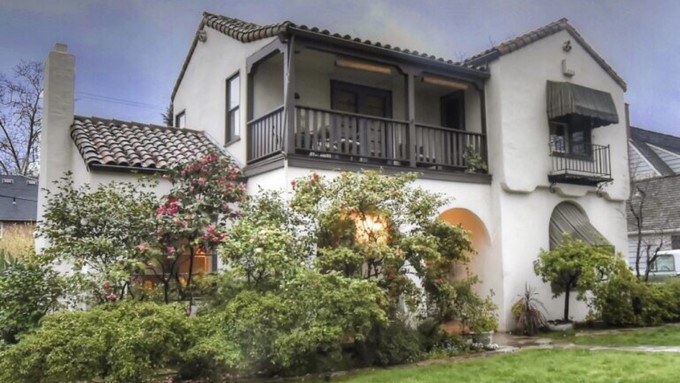
After five-year hiatus, popular event features five historic homes

This is one of the five homes on the 33rd Curtis Park Home and Garden Tour this Saturday, 10 a.m. to 4 p.m. Photo courtesy Sierra Curtis Neighborhood Association
It’s back! One of Sacramento’s favorite neighborhood traditions returns Saturday with the 33rd Curtis Park Home and Garden Tour.
Set for 10 a.m. to 4 p.m. Saturday, April 22, this popular tour has been on hiatus since 2018. Its first off-year in 2019, organizers needed a break after 32 consecutive spring tours. Little did they know that the pandemic would stretch that break into five years between events.
This Saturday, the tour is back in force with five private homes built – like most of the Curtis Park neighborhood – between 1910 and 1940. Their styles include Streamline Moderne, Mediterranean and Craftsman with interiors ranging from classic to contemporary. According to the organizers, featured gardens include entertaining spaces, English cottage designs and drought-tolerant landscapes.
Hosted by the Sierra Curtis Neighborhood Association, the tour supports the Sierra 2 Center for the Arts and Community and neighborhood programs. Advance tickets, available via the center’s website, are $25 for non-members of SCNA; tour day tickets are $30.
Whether buying in advance or on Saturday, start your tour at the booth at the corner of 26th Street and Donner Way on the north end of William Curtis Park. That’s where you’ll pick up your map and program, which acts as your passport into participating homes.
Each stop is located within walking distance of the park, where there also will be a celebration of Curtis Park’s history with displays, music, vendors, food and coffee. (That’s where the restrooms are located, too!) Among the vendors will be Light and Breezy Paper, Handmade, OB Woodworks, Kelsey Caroline Designs, Arizmendi Ceramics, Knott Just Art and Library Cat Designs.
Like classic cars? The Capitol A’s Model A Ford Club will tour around the neighborhood as well as display cars at participating residences. Watch plein air artists at work in some of the gardens, too.
Questions? Email events@sierra2.org.
Details and tickets: https://sierra2.org/event/home-tour/.
Comments
0 comments have been posted.Sacramento Digs Gardening to your inbox.
Food in My Back Yard Series
May 6: Maintain soil moisture with mulch for garden success
April 29: What's (already) wrong with my tomato plants?
April 22: Should you stock up on fertilizer? (Yes!)
April 15: Grow culinary herbs in containers
April 8: When to plant summer vegetables
April 1: Don't be fooled by these garden myths
March 25: Fertilizer tips: How to 'feed' your vegetables for healthy growth
March 18: Time to give vegetable seedlings some more space
March 11: Ways to win the fight against weeds
March 4: Potatoes from the garden
Feb. 25: Plant a fruit tree now -- for later
Feb. 18: How to squeeze more food into less space
Feb. 11: When to plant? Consider staggering your transplants
Feb. 4: Starting in seed starting
Sites We Like
Garden Checklist for week of May 11
Make the most of the lower temperatures early in the week. We’ll be back in the 80s by Thursday.
* Plant, plant, plant! It’s prime planting season in the Sacramento area. Time to set out those tomato transplants along with peppers and eggplants. Pinch off any flowers on new transplants to make them concentrate on establishing roots instead of setting premature fruit.
* Direct-seed melons, cucumbers, summer squash, corn, radishes, pumpkins and annual herbs such as basil.
* Harvest cabbage, lettuce, peas and green onions.
* In the flower garden, direct-seed sunflowers, cosmos, salvia, zinnias, marigolds, celosia and asters. (You also can transplant seedlings for many of the same flowers.)
* Plant dahlia tubers.
* Transplant petunias, marigolds and perennial flowers such as astilbe, columbine, coneflowers, coreopsis, dahlias, rudbeckia and verbena.
* Keep an eye out for slugs, snails, earwigs and aphids that want to dine on tender new growth.
* Feed summer bloomers with a balanced fertilizer.
* For continued bloom, cut off spent flowers on roses as well as other flowering plants.
* Add mulch to the garden to maintain moisture. Mulch also cuts down on weeds. But don’t let it mound around the stems or trunks of trees or shrubs. Leave about a 6-inch-to-1-foot circle to avoid crown rot or other problems.
* Remember to weed! Pull those nasties before they set seed.
* Water early in the day and keep seedlings evenly moist.